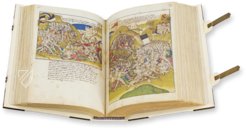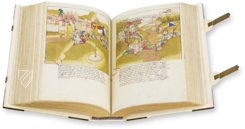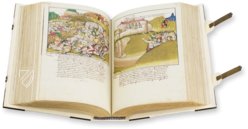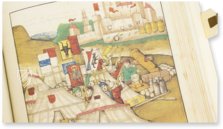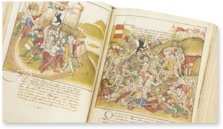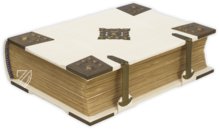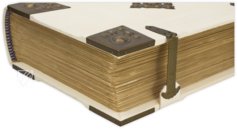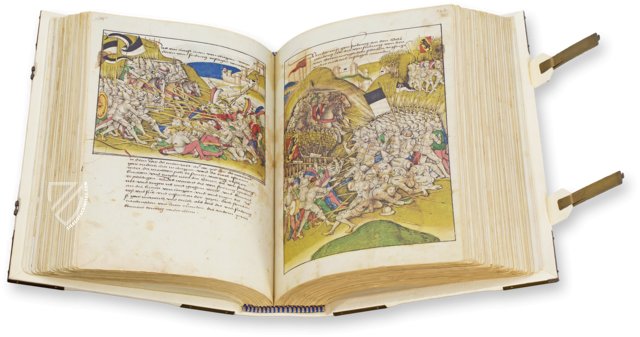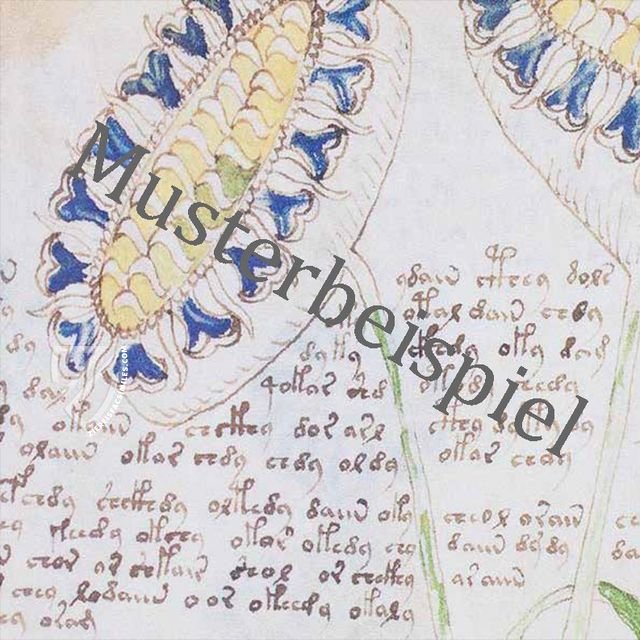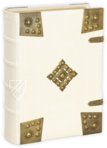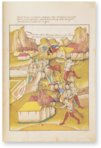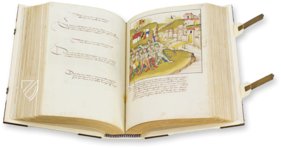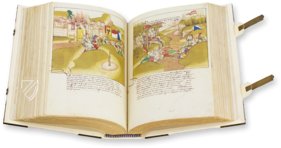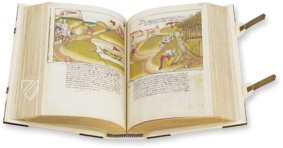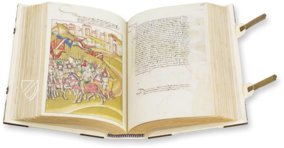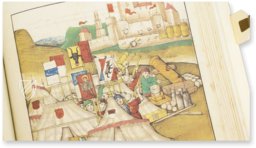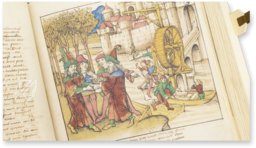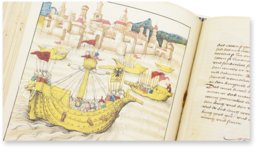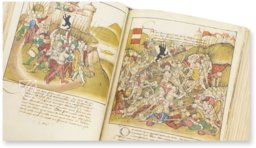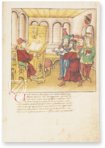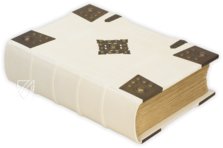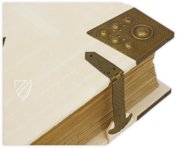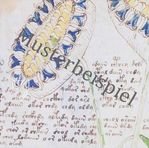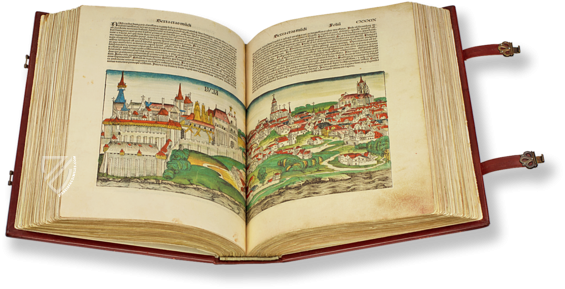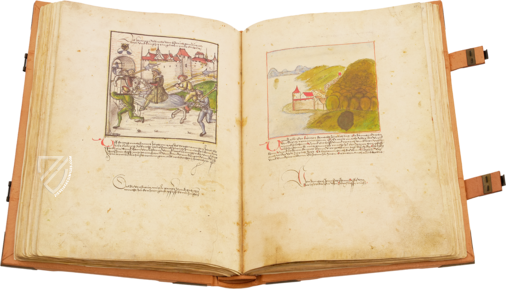Diebold Schilling's Spiez Illuminated Chronicle
(1,000€ - 3,000€)
The Spiez Illuminated Chronicle represents the end of the glorious series of city chronicles by Diebold Schilling. It is the chronicler’s most artistically significant work and gives proof of the Bernese master’s talent one last time with its exceptionally rousing illustrations. Rudolf von Erlach, a Bernese knight and friend of Schilling’s, commissioned the work in the early 1480’s. Schilling was responsible for both the elegant script and the 344 masterful miniatures that differ greatly in style to those in earlier chronicles and consist of pen and ink drawings glazed in different colors. Many seamlessly intertwine plotlines in the fore- and backgrounds while the human figures, usually, depicted with large eyes and serene expressions, are unusually realistic for the period.
Diebold Schilling’s Spiez Illuminated Chronicle
The so-called Spiez Illuminated Chronicle is the last work by the popular author and chronicler from Bern, Diebold Schilling. On 808 pages written in Schilling’s finest script, it depicts the history of the city of Bern from its beginnings to the year 1465. The work focuses on the family history and triumph of the Junker and councilman Rudolf von Erlach, who commissioned the work. The text is accompanied by 344 highly valuable illustrations.
The Commissioner, Rudolf von Erlach
Diebold Schilling produced the Spiez Chronicle for a private commissioner, namely the public official Rudolf von Erlach (1299–1360). They were close confidants to one another, Schilling’ wife was even godmother to a son of Rudolf’s. Rudolf von Erlach could look back on a glorious past, his family were among the most important people in the political system of Bern and he himself had fought in the conflict with the Burgundians for his homeland and thereby attained fame and honor as well as a high position in the council of Bern. He was at the highpoint of his extremely successful career at the time that he commissioned the Spiez Chronicle.
Schilling’s Masterpiece
In his work, Rudolf’s friend and chronicler bound the renowned history of the family with a self-confident image of the city of Bern, and therewith created his last and most artistically valuable masterpiece. He worked on it until his death in the year 1486. The elegant script stands in the tradition of Schilling’s famous previous works, e.g. the Zurich Chronicle.
Quality of the Highest Order
What makes the work especially admirable are the 344 miniatures contained therein, which are of a heretofore unknown quality. The pen and ink drawings, containing varying graduations of color, possess an uncannily expressive power and dramatic depth. The illustrator has succeeded in intertwining various plotlines in the picture and effectively synchronizing the fore- and backgrounds. In numerous illustrations, dramatic events of war are seen in the foreground, while ideal landscapes are revealed in the background through a window. In the text, scenes of war are predominantly depicted as well. The depictions of human figures are unusually realistic for the time of its creation and begets the extraordinary talent of the illuminator.
Codicology
- Alternative Titles
- Diebold Schillings Spiezer Bilderchronik
- Size / Format
- 808 pages / 39.0 × 28.0 cm
- Origin
- Switzerland
- Date
- 1484/85
- Epochs
- Style
- Language
- Illustrations
- 344 mostly full-page illustrations
- Patron
- Rudolf von Erlach (1448–1507), mayor of Bern
- Artist / School
- Diebold Schilling the Elder (ca. 1445 – ca. 1486)
Diebold Schilling's Spiez Illuminated Chronicle
Repelling a Cavalry Charge
Appenzell is a historic Swiss canton which is entirely surrounded by the larger canton of St. Gallen. With the help of Bern and other members of the Old Swiss Confederacy, they established their independence on May 15, 1403 at the Battle of Vögelinsegg by blocking a mountain pass and forcing the battle on their own terms. Identifiable by their bear flag, a phalanx of Bernese troops armed with pikes and halberds repel a charge by the knights serving the Prince-Bishop of St. Gallen.
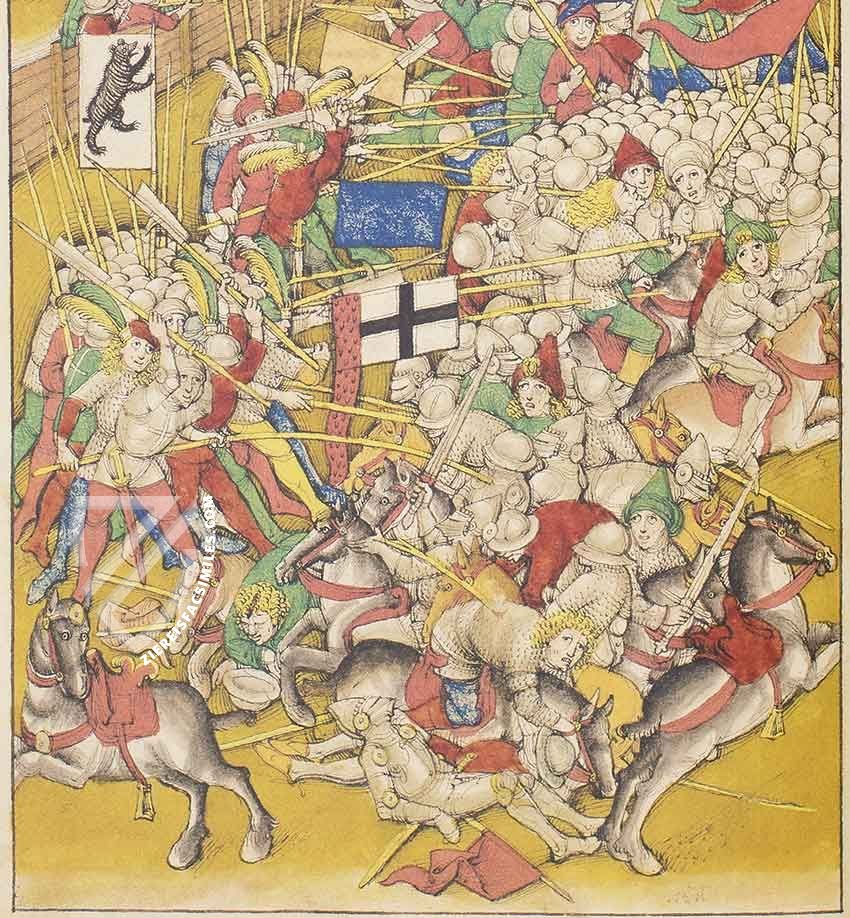
Diebold Schilling's Spiez Illuminated Chronicle
Third Stroke across the Grimsel into Valais, 1419
One of the events depicted in this history is the Raron Affair, a rebellion in the Canton of Valais from 1415 to 1420, which nearly caused a civil war within the Swiss Confederation. In 1419, Bernese troops once again crossed the Grimsel Pass to invade Valais in support of their allies, the Raron family, with an army of 13,000 that burned villages as it moved through the canton to punish the rebels.
Identified here by Bern’s coat of arms – the bear – the main column of soldiers emerges from the pass as a moving forest of pikes while other units set fire to buildings. These pen and ink drawings are considered to be the finest of any of Schilling’s chronicles and the human figures in particular are exceptionally realistic for the period.
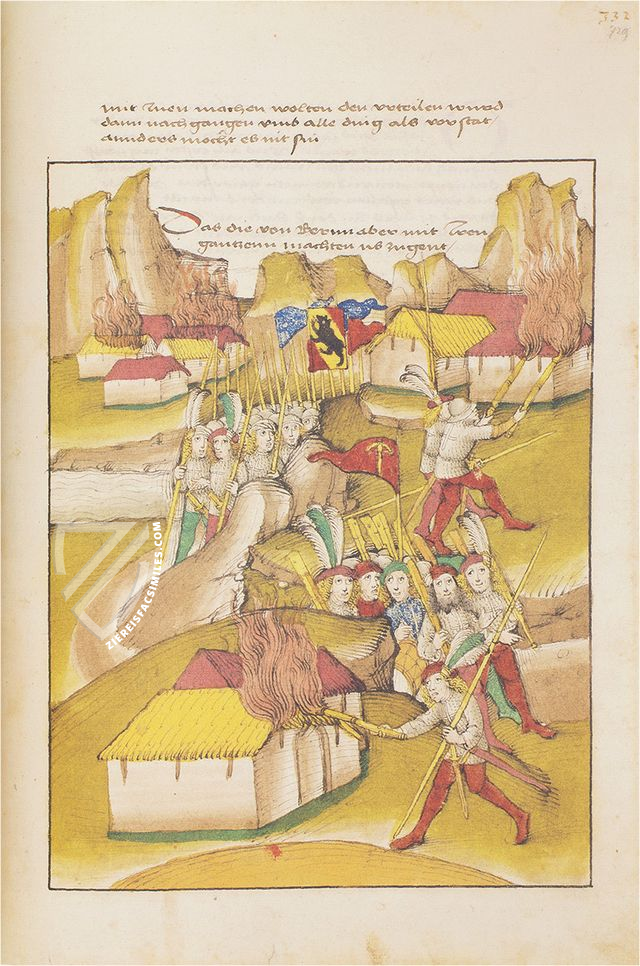
#1 Diebold Schillings Spiezer Bilderchronik
Language: German
(1,000€ - 3,000€)
#2 Diebold Schilling. Spiezer Chronik 1485.
- Treatises / Secular Books
- Apocalypses / Beatus
- Astronomy / Astrology
- Bestiaries
- Bibles / Gospels
- Chronicles / History / Law
- Geography / Maps
- Saints' Lives
- Islam / Oriental
- Judaism / Hebrew
- Single Leaf Collections
- Leonardo da Vinci
- Literature / Poetry
- Liturgical Manuscripts
- Medicine / Botany / Alchemy
- Music
- Mythology / Prophecies
- Psalters
- Other Religious Books
- Games / Hunting
- Private Devotion Books
- Other Genres
- Afghanistan
- Armenia
- Austria
- Belgium
- Belize
- Bosnia and Herzegovina
- China
- Colombia
- Costa Rica
- Croatia
- Cyprus
- Czech Republic
- Denmark
- Egypt
- El Salvador
- Ethiopia
- France
- Germany
- Greece
- Guatemala
- Honduras
- Hungary
- India
- Iran
- Iraq
- Israel
- Italy
- Japan
- Jordan
- Kazakhstan
- Kyrgyzstan
- Lebanon
- Liechtenstein
- Luxembourg
- Mexico
- Morocco
- Netherlands
- Palestine
- Panama
- Peru
- Poland
- Portugal
- Romania
- Russia
- Serbia
- Spain
- Sri Lanka
- Sweden
- Switzerland
- Syria
- Tajikistan
- Turkey
- Turkmenistan
- Ukraine
- United Kingdom
- United States
- Uzbekistan
- Vatican City
- A. Oosthoek, van Holkema & Warendorf
- Aboca Museum
- Ajuntament de Valencia
- Akademie Verlag
- Akademische Druck- u. Verlagsanstalt (ADEVA)
- Aldo Ausilio Editore - Bottega d’Erasmo
- Alecto Historical Editions
- Alkuin Verlag
- Almqvist & Wiksell
- Amilcare Pizzi
- Andreas & Andreas Verlagsbuchhandlung
- Archa 90
- Archiv Verlag
- Archivi Edizioni
- Arnold Verlag
- ARS
- Ars Magna
- ArtCodex
- AyN Ediciones
- Azimuth Editions
- Badenia Verlag
- Bärenreiter-Verlag
- Belser Verlag
- Belser Verlag / WK Wertkontor
- Benziger Verlag
- Bernardinum Wydawnictwo
- BiblioGemma
- Biblioteca Apostolica Vaticana (Vaticanstadt, Vaticanstadt)
- Bibliotheca Palatina Faksimile Verlag
- Bibliotheca Rara
- Boydell & Brewer
- Bramante Edizioni
- Bredius Genootschap
- Brepols Publishers
- British Library
- C. Weckesser
- Caixa Catalunya
- Canesi
- CAPSA, Ars Scriptoria
- Caratzas Brothers, Publishers
- Carus Verlag
- Casamassima Libri
- Centrum Cartographie Verlag GmbH
- Chavane Verlag
- Christian Brandstätter Verlag
- Circulo Cientifico
- Club Bibliófilo Versol
- Club du Livre
- CM Editores
- Collegium Graphicum
- Collezione Apocrifa Da Vinci
- Comissão Nacional para as Comemorações dos Descobrimentos Portugueses
- Coron Verlag
- Corvina
- CTHS
- D. S. Brewer
- Damon
- De Agostini/UTET
- De Nederlandsche Boekhandel
- De Schutter
- Deuschle & Stemmle
- Deutscher Verlag für Kunstwissenschaft
- DIAMM
- Droz
- E. Schreiber Graphische Kunstanstalten
- Ediciones Boreal
- Ediciones Grial
- Ediclube
- Edições Inapa
- Edilan
- Editalia
- Edition Deuschle
- Edition Georg Popp
- Edition Leipzig
- Edition Libri Illustri
- Editiones Reales Sitios S. L.
- Éditions de l'Oiseau Lyre
- Editions Medicina Rara
- Editorial Casariego
- Editorial Mintzoa
- Editrice Antenore
- Editrice Velar
- Edizioni Edison
- Egeria, S.L.
- Eikon Editores
- Electa
- Emery Walker Limited
- Enciclopèdia Catalana
- Eos-Verlag
- Ephesus Publishing
- Ernst Battenberg
- Eugrammia Press
- Extraordinary Editions
- Fackelverlag
- Facsimila Art & Edition
- Facsimile Editions Ltd.
- Facsimilia Art & Edition Ebert KG
- Faksimile Verlag
- Feuermann Verlag
- Folger Shakespeare Library
- Franco Cosimo Panini Editore
- Friedrich Wittig Verlag
- Fundación Hullera Vasco-Leonesa
- G. Braziller
- Gabriele Mazzotta Editore
- Gebr. Mann Verlag
- Gesellschaft für graphische Industrie
- Getty Research Institute
- Giovanni Domenico de Rossi
- Giunti Editore
- Graffiti
- Grafica European Center of Fine Arts
- Guido Pressler
- Guillermo Blazquez
- Gustav Kiepenheuer
- H. N. Abrams
- Harrassowitz
- Harvard University Press
- Helikon
- Hendrickson Publishers
- Henning Oppermann
- Herder Verlag
- Hes & De Graaf Publishers
- Hoepli
- Holbein-Verlag
- Houghton Library
- Hugo Schmidt Verlag
- Idion Verlag
- Il Bulino, edizioni d'arte
- ILte
- Imago
- Insel Verlag
- Insel-Verlag Anton Kippenberger
- Instituto de Estudios Altoaragoneses
- Instituto Nacional de Antropología e Historia
- Introligatornia Budnik Jerzy
- Istituto dell'Enciclopedia Italiana - Treccani
- Istituto Ellenico di Studi Bizantini e Postbizantini
- Istituto Geografico De Agostini
- Istituto Poligrafico e Zecca dello Stato
- Italarte Art Establishments
- Jan Thorbecke Verlag
- Johnson Reprint Corporation
- Josef Stocker
- Josef Stocker-Schmid
- Jugoslavija
- Karl W. Hiersemann
- Kasper Straube
- Kaydeda Ediciones
- Kindler Verlag / Coron Verlag
- Kodansha International Ltd.
- Konrad Kölbl Verlag
- Kurt Wolff Verlag
- La Liberia dello Stato
- La Linea Editrice
- La Meta Editore
- Lambert Schneider
- Landeskreditbank Baden-Württemberg
- Leo S. Olschki
- Les Incunables
- Liber Artis
- Library of Congress
- Libreria Musicale Italiana
- Lichtdruck
- Lito Immagine Editore
- Lumen Artis
- Lund Humphries
- M. Moleiro Editor
- Maison des Sciences de l'homme et de la société de Poitiers
- Manuscriptum
- Martinus Nijhoff
- Maruzen-Yushodo Co. Ltd.
- MASA
- Massada Publishers
- McGraw-Hill
- Metropolitan Museum of Art
- Militos
- Millennium Liber
- Müller & Schindler
- Nahar - Stavit
- Nahar and Steimatzky
- National Library of Wales
- Neri Pozza
- Nova Charta
- Oceanum Verlag
- Odeon
- Orbis Mediaevalis
- Orbis Pictus
- Österreichische Staatsdruckerei
- Oxford University Press
- Pageant Books
- Parzellers Buchverlag
- Patrimonio Ediciones
- Pattloch Verlag
- PIAF
- Pieper Verlag
- Plon-Nourrit et cie
- Poligrafiche Bolis
- Presses Universitaires de Strasbourg
- Prestel Verlag
- Princeton University Press
- Prisma Verlag
- Priuli & Verlucca, editori
- Pro Sport Verlag
- Propyläen Verlag
- Pytheas Books
- Quaternio Verlag Luzern
- Reales Sitios
- Recht-Verlag
- Reichert Verlag
- Reichsdruckerei
- Reprint Verlag
- Riehn & Reusch
- Roberto Vattori Editore
- Rosenkilde and Bagger
- Roxburghe Club
- Salerno Editrice
- Saltellus Press
- Sandoz
- Sarajevo Svjetlost
- Schöck ArtPrint Kft.
- Schulsinger Brothers
- Scolar Press
- Scrinium
- Scripta Maneant
- Scriptorium
- Shazar
- Siloé, arte y bibliofilia
- SISMEL - Edizioni del Galluzzo
- Sociedad Mexicana de Antropología
- Société des Bibliophiles & Iconophiles de Belgique
- Soncin Publishing
- Sorli Ediciones
- Stainer and Bell
- Studer
- Styria Verlag
- Sumptibus Pragopress
- Szegedi Tudomànyegyetem
- Taberna Libraria
- Tarshish Books
- Taschen
- Tempus Libri
- Testimonio Compañía Editorial
- Thames and Hudson
- The Clear Vue Publishing Partnership Limited
- The Facsimile Codex
- The Folio Society
- The Marquess of Normanby
- The Richard III and Yorkist History Trust
- Tip.Le.Co
- TouchArt
- TREC Publishing House
- TRI Publishing Co.
- Trident Editore
- Tuliba Collection
- Typis Regiae Officinae Polygraphicae
- Union Verlag Berlin
- Universidad de Granada
- University of California Press
- University of Chicago Press
- Urs Graf
- Vallecchi
- Van Wijnen
- VCH, Acta Humaniora
- VDI Verlag
- VEB Deutscher Verlag für Musik
- Verlag Anton Pustet / Andreas Verlag
- Verlag Bibliophile Drucke Josef Stocker
- Verlag der Münchner Drucke
- Verlag für Regionalgeschichte
- Verlag Styria
- Vicent Garcia Editores
- W. Turnowski Ltd.
- W. Turnowsky
- Waanders Printers
- Wiener Mechitharisten-Congregation (Wien, Österreich)
- Wissenschaftliche Buchgesellschaft
- Wissenschaftliche Verlagsgesellschaft
- Wydawnictwo Dolnoslaskie
- Xuntanza Editorial
- Zakład Narodowy
- Zollikofer AG




